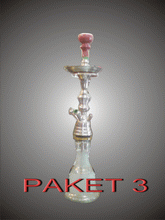In Iran, the hookah is known as a ghalyun (Farsi: قليان, قالیون, غلیون, also spelled ghalyan, ghalyaan or ghelyoon). It is similar in many ways to the Arabic hookah but has its own unique attributes. An example is the top part of the ghalyoun called 'sar' (Persian: سر=head), where the tobacco is placed, is bigger than the ones seen in Turkey. Also the major part of the hose is flexible and covered with soft silk or cloth while the Turkish make the wooden part as big as the flexible part.
Each person has his own personal mouthpiece (called an Amjid) (امجید), Amjid is usually made of wood or metal and decorated with valuable or other stones. Amjids are only used for their fancy look. However, all the Hookah Bars have plastic mouth-pieces.
Use of water pipes in Iran can be traced back to the Qajar period. In those days the hoses were made of sugar cane. Iranians had a special tobacco called Khansar (خانسار, presumably name of the origin city). The charcoals would be put on the Khansar without foil. Khansar has less smoke than the normal tobacco. Nasser al-Din Shah Qajar, Shah of Persia (1848-1896) is reputed to have considered a hookah mouthpiece pointed at him an insult.
The smoking of hookahs is very popular with young people in Iran, and many young people can be seen smoking them in local tea shops.
The hookah was, until recently, served to all ages; Iranian officials have since passed a law forbidding its use by those under 20.






No comments:
Post a Comment